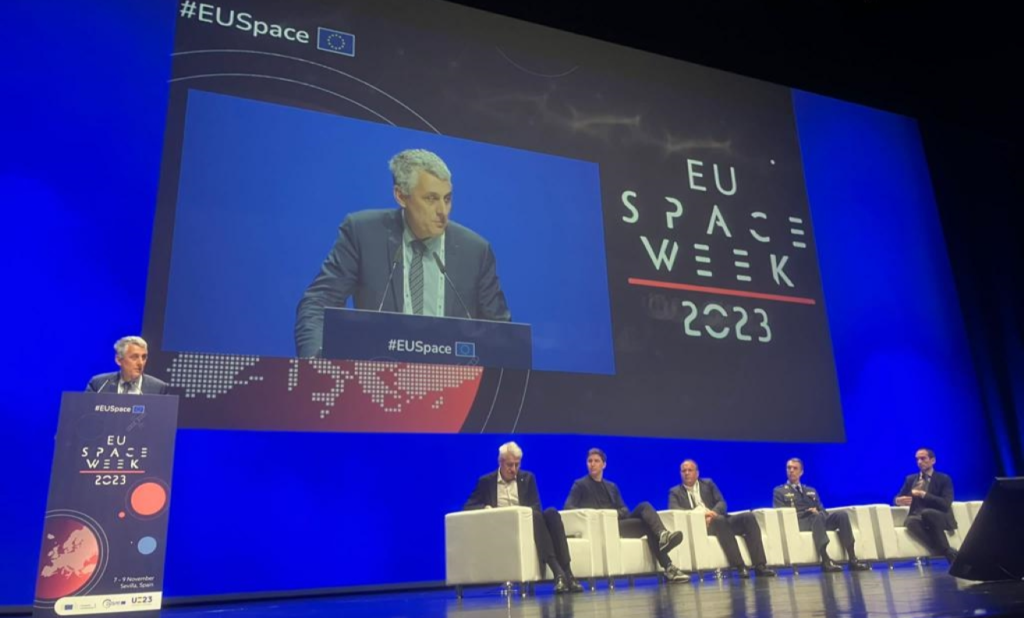Security in and from Space, a priority for Europe

Resilient positioning, timing and synchronisation services together with high-resolution imagery are vital tools during times of uncertainty and geopolitical tension. When coupled with secure satellite communications capabilities, these three technologies can support humanitarian and other military operations of the European Union and its Member States.
In recognition of the important role of space in defence and military operations, top EU legislators adopted the EU Space Strategy for Security and Defence (EUSSD) in March 2023. The EUSSD is a direct implementation of the EU Strategic Compass, in which space, together with cyber and maritime, were identified as contested strategic domains, the security of which must be ensured.
In a roundtable discussion moderated by Guillaume de La Brosse, Head of Unit Innovation & New Space - Space defence at DG DEFIS from the European Commission panellists representing OHB (Marcus Moeller), ICEYE (Rafal Modrzewski), the Exploration Company (Pierre Faucoup) and the Spanish Armed Forces (General Isaac Crespo Zaragoza) discussed challenges and opportunities.
OHB was involved in the design and development of the first generation of Galileo satellites and is currently contributing to the development of the new Secure Connectivity flagship constellation, IRIS2. Two essential elements according to Moeller are to enhance the dual use of space assets and the roll out tools so that Europe can ‘’act in space’’. For instance, he mentioned the development of an early warning system to be able to detect missiles from space. His views were shared by General Isaac Crespo Zaragoza, Chief of the Spanish Spatial Command who stressed the need to know what is happening in space, especially in such a congested environment.
During times of active conflict, such as the war in Ukraine, satellite products such as Synthetic Aperture Radar (SAR) images are indispensable tools for decision makers. SAR images can be captured through clouds and at night, providing a source of valuable intelligence for relevant military and governmental actors. According to the CEO of ICEYE, Rafal Modrzewski, the real added value of SAR in military operations is the high revisit time which constellations like ICEYE offer.
EUSPA, a fundamental security actor in European space
EUSPA has a large portfolio to deliver on, which includes the security of the EU Space Programme and its components in space and on the ground. As Philippe Bertrand, chair of the EU Space Programme Security Accreditation Board (SAB) explained, the Board evaluates the resilience and protection of the EU space systems and services, including the responses to threat attacks.
He noted that the development of accreditation standards by the SAB has helped to spread a security culture within the space industrial sector, where cyber security is key.
"The SAB’s independence gives insurance to users that security is independently assessed, and they can confidently utilise EU space services," concluded Bertrand.
The EU Space Week 2023 has been concluded by Elisa Rivera, Head of Cabinet of the Secretary General for Innovation, Ministry of Science and Innovation on behalf of the Spanish Presidency of the Council who recalled how important is the Space Programme of the EU to serve our fundamental European values, #Peace, #Security, #Sustainability, #WellBeing, #HumanRights… and how from the Space we can contribute to a more Stronger, United and Sustainable Europe closer to its citizens.
Media note: This feature can be republished without charge provided the European Union Agency for the Space Programme (EUSPA) is acknowledged as the source at the top or the bottom of the story. You must request permission before you use any of the photographs on the site. If you republish, we would be grateful if you could link back to the EUSPA website (http://www.euspa.europa.eu).